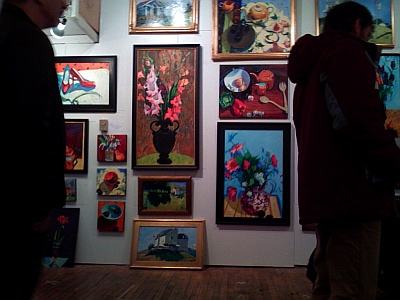My creative process for portraiture begins with what the
model projects. Body language is a very important part of
achieving a likeness. There fore I do not pose my models. I talk
with them after they seat themselves. The more we talk the
more comfortable they tend to become in the chair and in my
company. I watch them move about in the chair until I am struck
with a composition. Left to position them selves with no more
direction than sitting or standing, the subject will take a pose that
is characteristic of them.
Once we have a pose which suits both their comfort and my
inspiration I begin to choose back ground colors and set the lights.
Selecting the right size and proportioned canvas is next. I
begin drawing in charcoal on the canvas. Correcting the anatomy
and placement continuously. Developing the drawing can take up
to an hour or more. When satisfied I spray with fixative and begin
painting. I first analyze the subjects flesh tones and decide on the
colors I will use. I lay in my large dark shadow shapes first,
beginning with the eyes and then working all over the face and
down through the body. Constantly painting the colors and values
I identify. Then I paint in the local colors, or mid tone shapes.
Lastly I paint in the lights. I strive to cover the entire canvas with
paint as soon as possible. Since I work on a white canvas it is
important to establish and over state my values in the first
stages. Now I have my “knock in” which I will then devote hours
to repainting until I am satisfied with the finish. The face can take
me from six hours to infinity. Sometimes new starts are needed.
Portraiture is one of the more difficult expressions of
painting. It demands a command of the anatomy, color and
composition. The success of portrait painting is to first and
foremost commit myself to the art of making a good painting. A
well composed interesting painting conveying an inspired moment.
Ie: “A down ward glance.......”, “A woman in a red hat....” “A
woman defiantly smoking a cigarette.....”
I do not work from photos. The interaction between myself
and the model is of paramount importance. The animation of my
subject which occurs during our relaxed sessions is what helps me
to understand the structure of their face and body movements. In
which enables me to achieve the personality of the subject.
Secondly, the camera does not provide enough spacial depth (in
terms of subtle but necessary transitions of temperature and
intensity of color ) needed to recede or project the form in space.
Since my approach to all work is that of the impressionist school
working from life is essential with still life and plein air painting as
well as portraiture.
My approach to laying in a portrait is also the progression of
steps I use in all my work. I first decide what my most striking
impression is of my subject. Ie...the light.....the palette.....the
scale......the emotional response to a moment in time that will
never occur again.....etc.
I would say my most significant artistic accomplishment to
date was being commissioned by the Social Law Library
Committee of Boston, MA to paint their acting President, James
Brink in 1999. The painting resides in the State House Collection,
Boston, MA along with Sargent’s, Tarbell’s , Copley’s and over one
hundred others.
